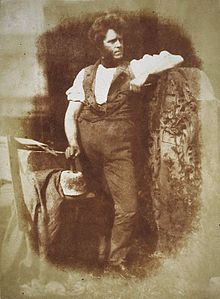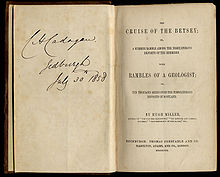Hugh Miller (geologist)
Hugh Miller (* 10. October 1802 in Cromarty ; † 24. December 1856 in Portobello , Edinburgh ) was a self-taught educated Scottish geologist and writer, narrative researchers and an evangelical Christian .
Life
Hugh Miller, born in Cromarty in the heart of Cromartyshire , was raised in a community school where he reportedly showed a love of reading. At 17 he began an apprenticeship as a stonemason , and his work in quarries and his fondness for walks on the nearby coast led him to study geology . In 1829 he published a volume of poetry and was shortly afterwards involved in religious and political controversy , first in connection with the then reform of the electoral law ( Reform Act 1832 ) and then the split in the Church of Scotland , the so-called "disruption" and the Creation of the Free Church of Scotland led.
In 1834, he was an accountant in one of the local banks and published the year after his work Scenes and Legends in the North of Scotland ( scenes and legends in northern Scotland ). In 1840, the majority wing of the moderates involved in the church dispute , with whom Miller was associated, founded a magazine called The Witness , and Miller was called to Edinburgh as editor , a position he held to the end of his life.
For much of 1856, Miller suffered excruciating headaches, and later hallucinations , and feared he might harm his family as a result of the delusions that led him to pursue conceited intruders with rifles. Miller died of suicide the night he had finally checked the proofs of his work The Testimony of the Rocks on fossil plants and vertebrates .
Miller's geological work
Miller left a legacy of new discoveries of various Silurian sea scorpions (Eurypterida) (the sea scorpion species Hughmilleria was named in his honor) as well as many Devonian fish, including several tank fish (the Arthrodire Millerosteus got his name after him), which he detailed in his popular Books. Although he did not hold a degree , he is now considered one of the most outstanding Scottish paleontologists .
Of his geological books, The Old Red Sandstone was probably the best known. Old Red Sandstone is still a name for sedimentary rocks that were deposited between the Late Silurian and Carboniferous after the Acadian Orogeny .
Although Miller's strong religiosity led him to bitterly fight the emerging theory of evolution, he was convinced that the earth was old and that the Flood was not of worldwide proportions.
His house in Cromarty is now a geological museum, with fossils from the immediate area. A weekend event was held here to mark the 200th anniversary of the Geological Society of London .
Works
Geological works
- The Old Red Sandstone (1841)
- Footprints of the Creator (1850)
- The Testimony of the Rocks (1856)
- Sketch-book of Popular Geology
Other subject areas
- My Schools and Schoolmasters , an autobiography
- First Impressions of England and its People (1847)
- The Cruise of the Betsey (1858)
literature
- Peter Bayne: The Life and Letters of Hugh Miller (2 volumes, 1871) ( online version )
- Lyall I. Anderson: Hugh Miller: introducing palaeobotany to a wider audience. In: AJ Bowden, CV Burek & R. Wilding (Eds.): History of Palaeobotany: Selected Essays . Geological Society of London, Special Publications, Vol. 241, pp. 63-90, 2005
Individual evidence
- ^ Lizanne Henderson: The Natural and Supernatural Worlds of Hugh Miller. In: Celebrating the Life and Times of Hugh Miller. Scotland in the Early 19th Century. Pp. 89-98, Ed. Lester Borley, Cromarty Arts Trust, 2003
- ^ John William Cousin: A Short Biographical Dictionary of English Literature . JM Dent & Co, London 1910 (accessed December 13, 2007).
- ^ Robert Farquharson Sharp: A Dictionary of English Authors, Biographical and Bibliographical. 1904, p. 198
- ^ Hugh Miller - 1802-1856
- ↑ History of the collapse of the flood theory and the "theory of the young earth"
- ↑ BBC News, "Local hero's shores 'fossil rich'" April 12, 2008.
Web links
- Hugh Miller (1802-56). Geologist, journalist and author. A Brief Biography by Samuel Smiles
- Discover Hugh Miller
- Scottish Authors> Hugh Miller Geologist, Journalist, Newspaper editor & Folklorist 1802-1856. SLAINTE: Information and Libraries Scotland ( Memento of 7 August 2007 in the Internet Archive )
- Deborah Painter: Hugh Miller's Old Fish-Story. Fossil News - Journal of Avocational Paleontology, 2001
| personal data | |
|---|---|
| SURNAME | Miller, Hugh |
| BRIEF DESCRIPTION | Scottish geologist, writer and storyteller |
| DATE OF BIRTH | October 10, 1802 |
| PLACE OF BIRTH | Cromarty |
| DATE OF DEATH | December 1856 |
| Place of death | Portobello , Edinburgh |

